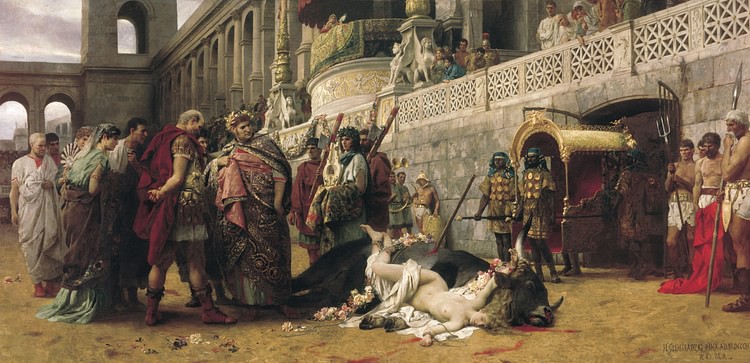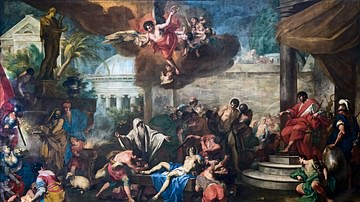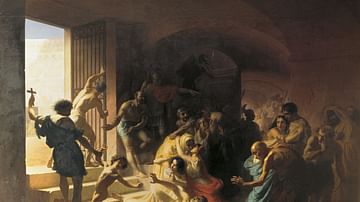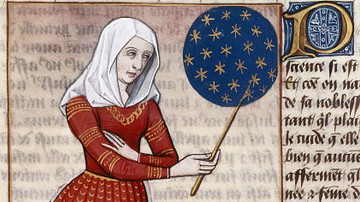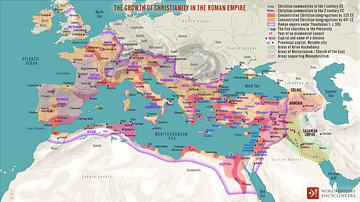Martyrologies, a unique genre of Christian literature, appeared from the 2nd century CE. A martyrology tells the story of the suffering and ordeals of a Christian martyr and details their trial and execution. A shared element of martyrologies was the claim that all martyrs experienced cradle-to-grave virginity, untouched by the mundane pollution of sexual intercourse. procreation, and the sin of lust.
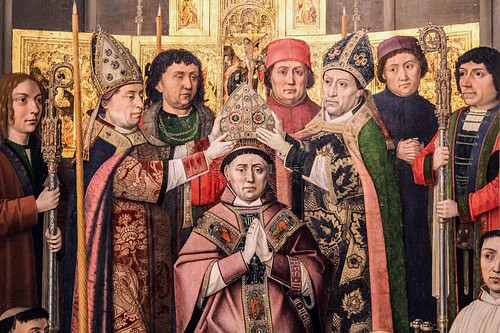
The Concept of Martyrdom
Rome's response to the spread of Christianity at the end of the 1st century included persecution, officially during the reign of the Emperor Domitian (r. 81-96). Christians were charged with the crime of atheism, disbelief, and non-participation in the state cults of the Roman Empire. Non-participation was seen as angering the gods, which imperiled everyone, and so atheism meant that you did not want the Empire to prosper. This was equivalent to treason, which everywhere and always carried a death penalty. Thus, "Christians to the lions . . . "
The Christian response to persecution was to adopt the Jewish concept of martyrdom from the story of the persecution of Jews during the Greek occupation and the subsequent Maccabean Revolt against Greek rule (167 BCE). The term "martyr" meant "witness" in the sense of court testimony, "witnessing to the truth." Martyrdom became a sacrifice, offering one's life for one's religious convictions. The reward was resurrection in heaven after death.
The books of the Maccabees utilized earlier concepts from the books of Jewish prophets. The Assyrian conquest of Northern Israel (722 BCE) and the Babylonian conquest and destruction of the first Temple in Jerusalem (587 BCE) caused a theological crisis. Difficult questions had to be answered: Were the gods of the Assyrians and Babylonians greater than the God of Israel? Why did God allow this to happen?
The prophets claimed that the God of Israel was still the mightiest, but utilized the other nations to punish Israel for their consistent lapses into idolatry, the worship of other gods. Polemically, idolatry led to the sexual immorality of non-Jews, Gentiles (the later pagans of Christianity). Highlighted in the Maccabee literature, political oppression was equated with sexual immorality: "For the temple was filled with debauchery and reveling by the nations, who dallied with prostitutes and had intercourse with women within the sacred precincts and besides brought in things for sacrifice that were unfit" (2 Maccabees 6:4). Jews created 'vice lists' of Gentile lifestyles. The letters of Paul the Apostle to the Gentiles contain the same polemical vice lists against the dominant culture of the Roman Empire.
The Church Fathers
During the separation of Christianity from Judaism, most of our literature comes from the writings of a group retrospectively titled the Church Fathers of the 1st to the 4th centuries. As Christianity evolved and became institutionalized, these writers were later deemed experts in their views. They responded to the critiques of early Christianity from the dominant culture as well as debates among the various Christian communities. This literature contributed to what eventually became Christian dogma, or the official teachings and beliefs of the Church.
By this period, the majority of Christians were converted pagans and no longer held to the self-identity markers of Judaism, circumcision, or dietary laws. But they retained the basic elements of Judaism, arguing that Christianity fulfilled the prophets of Israel, with the coming of a messiah figure, Jesus of Nazareth. The major contributions came from the writings of Justin Martyr (100-165), Irenaeus of Lyons (c. 130 to c. 202), Clement of Alexandria (c. 150- 215), and Tertullian (155-220).
This period saw the formation of church hierarchy, the election of bishops ("overseers") and deacons. Bishops and deacons became the administrators of the community. In a collection of letters known as the Pastorals (1 & 2 Timothy; Titus), we have rules for the election of bishops that absorbed the social conventions of Roman society and the family:
The saying is sure: whoever aspires to the office of bishop desires a noble task. Now a bishop must be above reproach, married only once, temperate, sensible, respectable, hospitable, an apt teacher, not a drunkard, not violent but gentle, not quarrelsome, and not a lover of money. He must manage his own household well, keeping his children submissive and respectful in every way— for if someone does not know how to manage his own household, how can he take care of God's church? He must not be a recent convert, or he may be puffed up with conceit and fall into the condemnation of the Devil. Moreover, he must be well thought of by outsiders, so that he may not fall into disgrace and the snare of the Devil.
(1 Timothy 3:1-7)
A married bishop promoted the Christian claim that they adhered to the age-old concepts of the religious duty of the man as the head of the family to procreate and produce offspring for the good of the community.
The Authority of Bishops
In communities of different ethnic identities (former Jews, pagans, and Christians), in theory, all are equal by receiving salvation, so why should a bishop have authority over the others? Christian leaders adopted the concepts of celibacy and chastity. Celibacy meant not legally entering into a marriage contract; chastity was not participating in sexual intercourse. This elevated the bishops above the masses; it provided an aura of holiness to their persons. Christians created the ritual of penance, where the bishop had the power to forgive sins on earth. This is when we see the emergence of the Christian concept of human sexuality as sin; intercourse was only to be condoned for the procreation of children.
Simultaneously, we have the concept of living martyrs. In other words, a bishop did not have to die in the arenas to be a martyr. Their sacrifice was giving up the normal conventions of marriage and children, devoting themselves to God and the community. They received the same reward of existence in Heaven after death.
Retrospectively, Christians read back concepts of celibacy and chastity into the legends and martyrologies of the earliest Christians, beginning with the disciples of Jesus. Virginity in the ancient world simply indicated the youthful state before puberty; there was no connotation of a theological concept. But the renunciation of normal sexual behavior became an ideal theological existence for Christians.
Acts of the Apostles
Beyond the gospels, we have little contemporary information about the original disciples of Jesus. The four canonical gospels were not assigned to a writer until the middle of the 2nd century. This is when Mark, Matthew, Luke, and John received their names, with rationales that provided a provenance of where they were written.
"Disciple" meant "student" or "follower." The Acts of the Apostles (attributed to the writer known as Luke) described the way in which the disciples began missions from Jerusalem to the Eastern cities of the empire. They are now described as "apostles," which meant a "herald," or someone who brings a message. The apostles, the first Christian missionaries, brought the message of the 'good news' of the impending kingdom of God on earth.
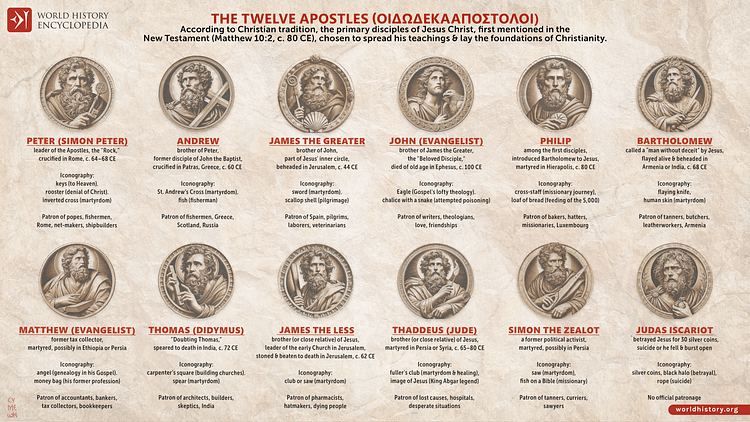
Then (as now), there was interest in the lives of the disciples, particularly what happened to them after Jesus ascended to heaven. Beginning in the 2nd century and beyond, apocryphal writings (meaning not eventually accepted into the canon of the New Testament) and acts (deeds) of the apostles proliferated. They all shared two major themes: the stories claimed that the original apostles were celibate and chaste, and they all died as martyrs.
Acts of Thomas
One of the original disciples, Thomas traveled from Jerusalem as far as India. Indian Christians claim him as their founder; his tomb is in the Indian state of Goa. Along the way, he traveled through all the empires of the Middle East, converting people everywhere. The dominant theme of his story is highlighting celibacy and chastity.
In a typical Thomas story, he is invited (either by a local king or magistrate) to attend a wedding. Thomas pulls the couple aside and talks them out of consummating their marriage that night. Everywhere that Thomas visited, we have long speeches on celibacy and chastity. In one scene, Jesus appears sitting on the marriage bed of a couple, listing all the polluting things involved in sex and the risks of childbirth. The story ends with Thomas' martyrdom in India, pierced with spears because he had converted the king's wives, who then chose chastity.
Acts of Peter
The Acts of Peter is one of the longest and fullest stories that has survived. Some of the information was obtained from the gospels and Acts, but other sources remain unknown. The first miracle described by Mark took place in the synagogue at Capernaum, and then Jesus and the disciples retired to Peter's house. We are told that Peter's mother-in-law was ill, so Jesus cured her. She then got up and cooked for them. From our earliest evidence (the letters of Paul), we know that some of the disciples had wives. As part of 1 Corinthians 9, Paul argued that he should have as much authority as the original disciples, who apparently received support from the communities: "Am I not free? Am I not an apostle? . . . Do we not have the right to our food and drink? Do we not have the right to be accompanied by a believing wife, as do the other apostles and the brothers of the Lord and Cephas?" But this is the last we hear of any wives of the apostles.
By the 2nd century, Peter was described as a widower, which kept him celibate. We also learn that he had a daughter from his first marriage, who traveled everywhere with him and helped him with the mission. However, as she approached puberty, many men petitioned Peter for her hand in marriage. Peter was torn over what to do. He prayed to God (and/or Jesus) for guidance. His daughter was then struck with a lightning bolt and was crippled for life. This was understood as a divine miracle; no man wanted her after that. She was now free to continue her father's work as a virgin. We have her name, Petronilla, only in later traditions, and a claim that her tomb was in Rome. Peter died as a martyr during the alleged persecution under Nero after the fire of Rome in 64.
Greek Romance Novels
The writers of the stories of the apostles utilized a popular genre of storytelling, the Greek romance novel. This is a familiar genre because not only was it utilized by Christian writers but it was also eventually replicated over the centuries in fairy tales, Harlequin romance novels, soap operas, and popular movie versions known as rom-coms. They all contain the same pattern:
- Boy meets girl, and they fall in love. Either they belong to the wrong classes or the parents disapprove for various reasons, so they are separated.
- Girl gets kidnapped by pirates or falls under the sway of some evil villain.
- Boy sets out to search for her.
- Boy always has a best friend, a sidekick, who provides comic relief.
- They both have adventures, usually a shipwreck or two, and the girl is always being threatened with rape or near rape, but her virginity remains intact. There is often a magistrate or high-status official who is in love with her and tries to force her into marriage.
- Sometimes the gods intervene to save them in these adventures.
- They finally reunite, get married, and live happily ever after.
The Acts of the Apostles utilized all of these elements as action-adventure romances, but with several Christian twists. Instead of encountering pirates, Christians suffer and are persecuted by governing authorities for their faith. Comic relief is shown in the muddled confusion of the persecutors when they attempt to execute martyrs. Divine winds always put out the fires when they attempt to burn them at the stake. In the venatio games ("wild animal hunts"), the animals refuse to eat them. Most often, the martyr has to take the initiative of killing himself/herself in a final act of devotion.
By the 2nd century, the belief was that if you had the spirit of God, you could not lead a normal life; it meant no sex. Instead of the typical living happily ever after as lovers, happily ever after was their success in miraculously converting pagans and being rewarded with heaven after death.
Virgin Martyrs
Later martyrologies highlighted famous women martyrs as virgin martyrs. These stories follow a similar imposed pattern. The conditions of prisoners in holding cells was dire: dark, damp, and full of rats. The physiological conditions (little or no food) of impending martyrs as well as their emotional conditions (contemplating torture and death) often combined to produce visions.
Three examples are from the stories of Agatha of Sicily (231-251), Agnes (291-304), and Catherine of Alexandria (287-305). Agatha and Agnes claimed visions and visitations of Mary, mother of Jesus, and her child. Someone from the nobility always claimed to fall in love with the women, but they refuse all attempts at seduction or marriage.

Roman law forbade the execution of a virgin; virgin girls had to be raped in their cells first. A common plot in these stories was having the accused sent to a brothel for forced rape and torture. Agatha had her breasts cut off, symbolic of rejecting sexuality and motherhood. But miracles often intervened. The men who attempted to rape Agnes were immediately struck blind.
As a young girl, Catherine of Alexandria claimed to have a vision of Mary and the Christ child who placed a ring on her finger, committing herself to a mystical marriage with Christ and shunning traditional marriage. When Emperor Maxentius permitted her to plead against the persecutions, he called in philosophers and orators for a debate, but the result was that they all converted to Christianity. Catherine was condemned to be tied to a torture device, a breaking wheel, but it broke. Modern rotating fireworks that incorporate multiple displays in city festivals are called "Catherine wheel fireworks."
From Councils to Canon Law
Although mandated in the 2nd century, it was apparent that many bishops continued to marry, adopt mistresses, and produce offspring. It would take several centuries (and several council meetings) to finalize Catholic clerical celibacy into canon law. One of the earliest references was the Council of Elvira (Spain, 306):
Bishops, presbyters, deacons, and others with a position in the ministry are to abstain completely from sexual intercourse with their wives and from the procreation of children. If anyone disobeys, he shall be removed from the clerical office
(Canon 33).
Emperor Justinian I (r. 527-565) declared that any such marriages were null and void and the offspring illegitimate.
The First Lateran Council (1123) forbade any association by priests, deacons, and monks with concubines (legal, second wives) or women who were not relatives. In the medieval period, scandals arose from clerics marrying themselves to women and the appointing of illegitimate sons to the clergy. The Borgia Pope Alexander VI (r. 1492-1503) made his illegitimate son, Cesare Borgia, a cardinal. Celibate clergy only became officially canonized in the Catholic Church under Pope Benedict XV in 1917.



